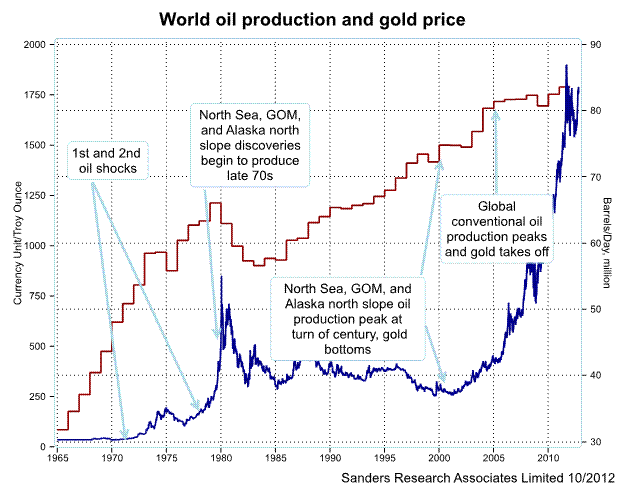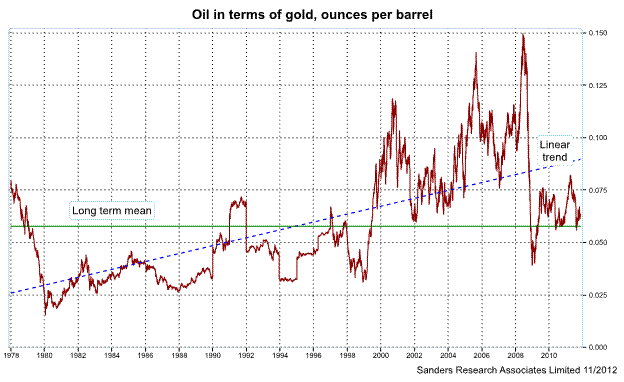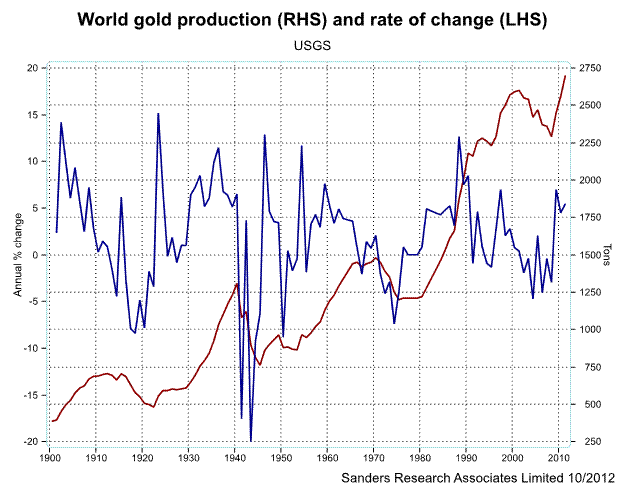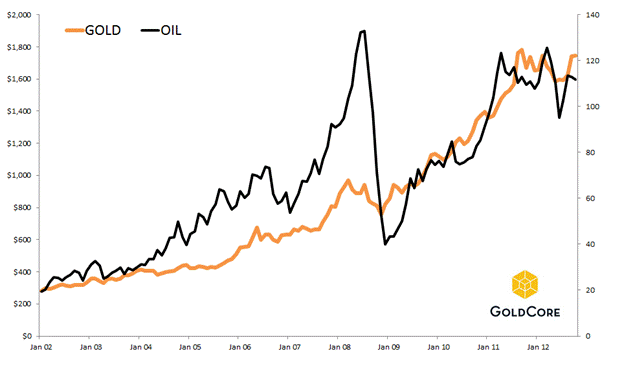Own Physical Gold Now - While You Still Can!
Commodities / Gold and Silver 2012 Dec 09, 2012 - 06:38 AM GMTBy: GoldCore

 “Farther from care than danger…”
“Farther from care than danger…”
The title above is a quote from Sir Thomas More’s classic, Utopia, describing a people’s overconfidence in their capacity for navigation given the compass for the first time.
I found the quote used by Stanley Jevons in his 1866 classic of another sort, The Coal Question. Jevons was writing about the physical limits to coal production, and forecasting, with some accuracy, the inevitable consequence of a peak, decline and exhaustion of Britain’s coal reserves.

Jevons, a political economist, was ridiculed at the time, and turned his attention – in his published work at least – to more abstract economic theorization.
Not much has changed since Jevons’s time. Economists, at least of the neoclassical mainstream variety, still don’t like the facts of life in the physical world.
Our navigators, the economists
The alchemy of price supposedly converts real world problems such as the depletion of easy-to-find-and-produce resource reserves, such as oil, or waste disposal and environmental degradation – think Fukushima – to an opportunity. The reasoning goes that for enough money, someone will find an alternative or invent one.
Main stream economists don’t have much time for systems engineers, ecologists or biologists who also analyze these difficult issues.
Over the course of the last hundred years economics has become the compass by which we navigate the shoals of socio-political life, and economists are the navigators.
Judging from the results of the last thirteen years, in which we have watched the world banking system and financial markets collapse, and experienced multiple epic industrial disasters of which the BP Macondo well explosion and the Fukushima triple meltdown are the latest and most horrific, you might think that the navigators would be looking for other employment, but they aren’t and most likely won’t.
The best economic forecast ever wasn’t even a forecast, and it wasn’t the work of economists
The fact is that one of the most successful economic “forecasts” in history was inspired by Jay Forrester, and was not in fact intended as a forecast at all.
Forrester was a professor at MIT modeling the interactions of electrical and industrial systems. His work led him to model more complex socioeconomic systems, ultimately resulting in the publication of a book, World Dynamics, in 1971.
His student Dennis Meadows and three others collaborated under the auspices of the Club of Rome to produce what they called The World Model. This was a computer simulation of the evolution of the global system: changes in industrial production, agricultural output, resource consumption, pollution, population given a set of parameters and assumptions. The result of their collaboration was a small book titled The Limits to Growth, published in 1972.
The book is, for the most part, simply a simulation of several scenarios: a base case in which business as usual carries on indefinitely and a variety of other scenarios to test hypothetical policy choices, technological changes, resource availability and so on. It was, in short, an exercise in scenario building, hypothesis testing and risk evaluation.1
Business-as-usual: the base case for disaster
In the World Model base case of business as usual, industrial production increases until the early years of the 21st century, when it rolls over and begins a long and irrecoverable decline. This is very interesting for several reasons, the most important of which is that industrial production is a good proxy for primary energy consumption.
World conventional oil production peaked in 2005. Since then world primary energy consumption has been maintained (and even increased a bit) by the exploitation of tar sands, very deep-water offshore oil production, shale oil and gas production, and most of all, much higher coal production.
This is significant because it means that a growing proportion of capital is being allocated to the process of finding, extracting and refining primary energy resources of declining quality. This in turn means that there is a limit to the growth prospects of the world industrial base, whatever its location. The economic problem is that investment is failing to keep up with depreciation of the underlying asset stock.
It’s easy to see why the mainstream economics profession, when it recovered from the shock of seeing the words “limits” and “growth” in the same title, rallied to destroy the book’s and its authors’ credibility. An early critique was titled “Models of Doom,” which gives you the authors’ thesis in a nutshell. As time passed criticism of the book evolved into what was fundamentally simply a statement that “it was wrong.”
How could an exercise in scenario building using simulations be “wrong?”
One man’s garbage is another man’s treasure
Nevertheless, some economists just can’t let it go. As recently as 2008, Paul Krugman, New York Times columnist, Nobel laureate in economics and an economics graduate student at MIT at the time the book was published, trashed the book and especially Jay Forrester, saying “…the study was a classic case of garbage-in-garbage-out: Forrester didn’t know anything about the empirical evidence on economic growth or the history of past modelling efforts, and it showed.” 2
Clearly a methodology so clear and so simple as creating a simulation and then running alternative scenarios to assist a decision making process is too straightforward for the smartest economists. Therein lies the indictment of the economists: they never made the decision to act, preferring instead to ignore the problem that the model’s runs defined by assuming that markets and prices would solve it for them. Now what’s that about garbage in, garbage out?3
Consequently, the world is allocating more labour, physical and financial capital to support primary energy production in order to maintain a semblance of the status quo ante, which is another way of saying that the World Model base case is a very close approximation to what has actually happened. This has created a confusing analytical environment for economists, politicians, investors and corporate planners, all of whom would undoubtedly prefer business – and crucially consequences – as usual.
Unfortunately, as we are seeing world-wide, the consequences part is not cooperating.
Actually, the analytic problem is fundamentally not confusing at all; difficulties only arise as a result of the deeply ingrained habit of assigning a price denominated in currency to, literally, everything.
We have become a civilization of people who, like Oscar Wilde’s cynic, know the price of everything and the value of nothing.

The real foundation of the economy: energy
Simple observation shows that everything in life happens because of energy flows. Our industrial civilization is based on the processing and use of fossil solar energy extracted from the ground. It takes energy to perform the tasks of finding, extracting and processing the coal, oil and gas in which that fossil solar energy is embodied. It is only common sense that as it becomes more difficult to do these things more and more energy will be consumed in the process of the doing.
A deep water exploration and drilling rig costs a billion dollars a rig and most of the wells it drills are dry. This is a far cry from poking a pipe in the ground in 19th century Pennsylvania and watching a gusher flow.
Energy (and therefore the economy) is becoming more expensive and is doing so at an increasingly rapid clip. This is why the peak in global conventional oil production that occurred in 2005 is so important.
The world is spending increasing amounts of higher quality energy – that is oil, gas and coal extracted earlier from easier-to-get sources – to produce lower quality energy from harder-to-get and more depleted sources. And this is also why, at bottom, the policy of unrestricted debt monetization pursued by the European, American and Japanese governments will be unsuccessful in reviving their real economies and will ultimately be unlikely to revive the banks that the policy is meant to save.

A golden renaissance?
No wonder gold is enjoying a renaissance as a monetary instrument and store of value.
Over the last forty-two years gold has reacted sharply to every significant change in the oil market. The oil shocks of the 1970s both resulted in huge moves in the gold price that were not capped until significant new supply came on stream in the form of discoveries in Alaska, offshore Gulf of Mexico and the North Sea.
Gold sank for some twenty years until production from those three provinces peaked. Gold bottomed in 2001 and then climbed by some 65% by 2005 when global conventional oil production peaked.
Since peak oil production in mid-2005, gold has risen strongly, rising over 360% in seven years (see chart above).
Given all this, the development of shale oil and gas and of tar deposits in Canada, Venezuela and elsewhere is of great interest.
Were it to be exploitable on a par with say, Saudi Arabia as Saudi Arabia’s oil endowment was fifty years ago, it would be a clear signal that the bull market in gold would be near an end.
This is unlikely, for the simple reason that neither source of fuel is of a quality commensurable with conventional light crude and the impact of both on the market has been over-hyped.
Recoverable shale oil and gas is, after ten years of experience, likely much lower than promised, and it depletes at a rapid rate. A typical well produces 75-80% of its ultimate production in just two years. Unlike conventional oil and gas wells that are drilled and produce for years, this means that drilling has to accelerate exponentially to maintain production in an established production province, never mind increase. It is a massively energy and capital intensive process, on a par with the mining and processing of bitumen for fuel.
Indeed, it appears that the initial boom in the shale oil and gas industry appears to have run its course. Shale oil requires a WTI price of around $80 a barrel to make financial sense for the producers; shale gas requires a price of around $8 per billion cubic feet.
The greater global integration of the oil industry has kept prices high enough, but an intensification of the global recession will change that.
The isolation of the North American gas market has meant that the price there has collapsed with the influx of shale gas, and may put many of the companies that rushed in, out of business.
Peak oil and peak energy means that gold is an attractive diversification for individuals, institutions, corporations and central banks – and will become increasingly so.
It also means that the sharp price fall that gold experienced in 1980 are less likely. Prices may be volatile and there will be sharp corrections but gold is likely to settle at a higher plateau in the coming years rather than a price collapse.

But there is another reason why gold remains attractive, and that is simply that it, too, is a depleting resource and a unique one. The once dominant role of South Africa has declined significantly with gold production having peaked in the 1970’s and falling sharply ever since. Other producers such as China have developed to fill the gap between supply and demand – but there are question marks over some of the figures coming out of China. Despite the increase in Chinese production, world gold production has been slow to respond while the gold price has risen.
This is a physical problem as much as a financial one. The rising energy price of primary energy production translates into much higher energy costs for miners.
They are being forced to extract and separate increasingly hard-to-get and dilute fractions of ore. This raises serious questions about the outlook for their long term profitability. Increasingly, production is a by-product of mining for other minerals from increasingly dilute fractions of gold.
None of this, though, seems to bother the navigators of our ship, who are stubbornly steering us farther from care than danger on a course across an ocean of debt to follow the great white whale of business as usual. These are interesting times alright, and historically interesting times have been the best times to own real, tangible, physical gold.
Somewhere, of course, where the navigators can’t steal it.
Chris Sanders
Disclosure: The author is a long-term investor in and owner of physical gold
1 The story of their work, the reactions to it, and its implications is told by Ugo Bardi in his book The Limits to Growth Revisited, Springer, 2011.
2 See Krugman’s article on http://krugman.blogs.nytimes.com/2008/04/22/limits-to-growth-and-related-stuff/. Interestingly, he does acknowledge that progress on finding alternatives to conventional oil has consistently fallen short of expectations.
3 When Forrester started his modeling work in the mid-60s he had to develop his own computer to do the work. Bardi, op. cit. p86.
Chris Sanders - Biography
Chris Sanders is the Managing Director of Sanders Research Associates Limited, an open-source intelligence consultancy. He has spent more than thirty years in international banking and investment management in Europe and the Middle East. From 1996 to 2007 he was a visiting professor in international finance at the University of Gothenburg in Sweden.
Chris Sanders is now working with the GoldCore research team and will be researching and writing research articles for GoldCore. His experience in and knowledge of the world of finance and energy will be important in helping to inform about the macroeconomic, monetary, geopolitical and geological challenges facing the global economy and us all today.
For the latest news and commentary on financial markets and gold please follow us on Twitter.
GOLDNOMICS - CASH OR GOLD BULLION?

'GoldNomics' can be viewed by clicking on the image above or on our YouTube channel:
www.youtube.com/goldcorelimited
This update can be found on the GoldCore blog here.
Yours sincerely,
Mark O'Byrne
Exective Director
IRL |
UK |
IRL +353 (0)1 632 5010 |
WINNERS MoneyMate and Investor Magazine Financial Analysts 2006
Disclaimer: The information in this document has been obtained from sources, which we believe to be reliable. We cannot guarantee its accuracy or completeness. It does not constitute a solicitation for the purchase or sale of any investment. Any person acting on the information contained in this document does so at their own risk. Recommendations in this document may not be suitable for all investors. Individual circumstances should be considered before a decision to invest is taken. Investors should note the following: Past experience is not necessarily a guide to future performance. The value of investments may fall or rise against investors' interests. Income levels from investments may fluctuate. Changes in exchange rates may have an adverse effect on the value of, or income from, investments denominated in foreign currencies. GoldCore Limited, trading as GoldCore is a Multi-Agency Intermediary regulated by the Irish Financial Regulator.
GoldCore is committed to complying with the requirements of the Data Protection Act. This means that in the provision of our services, appropriate personal information is processed and kept securely. It also means that we will never sell your details to a third party. The information you provide will remain confidential and may be used for the provision of related services. Such information may be disclosed in confidence to agents or service providers, regulatory bodies and group companies. You have the right to ask for a copy of certain information held by us in our records in return for payment of a small fee. You also have the right to require us to correct any inaccuracies in your information. The details you are being asked to supply may be used to provide you with information about other products and services either from GoldCore or other group companies or to provide services which any member of the group has arranged for you with a third party. If you do not wish to receive such contact, please write to the Marketing Manager GoldCore, 63 Fitzwilliam Square, Dublin 2 marking the envelope 'data protection'
GoldCore Archive |
© 2005-2022 http://www.MarketOracle.co.uk - The Market Oracle is a FREE Daily Financial Markets Analysis & Forecasting online publication.


